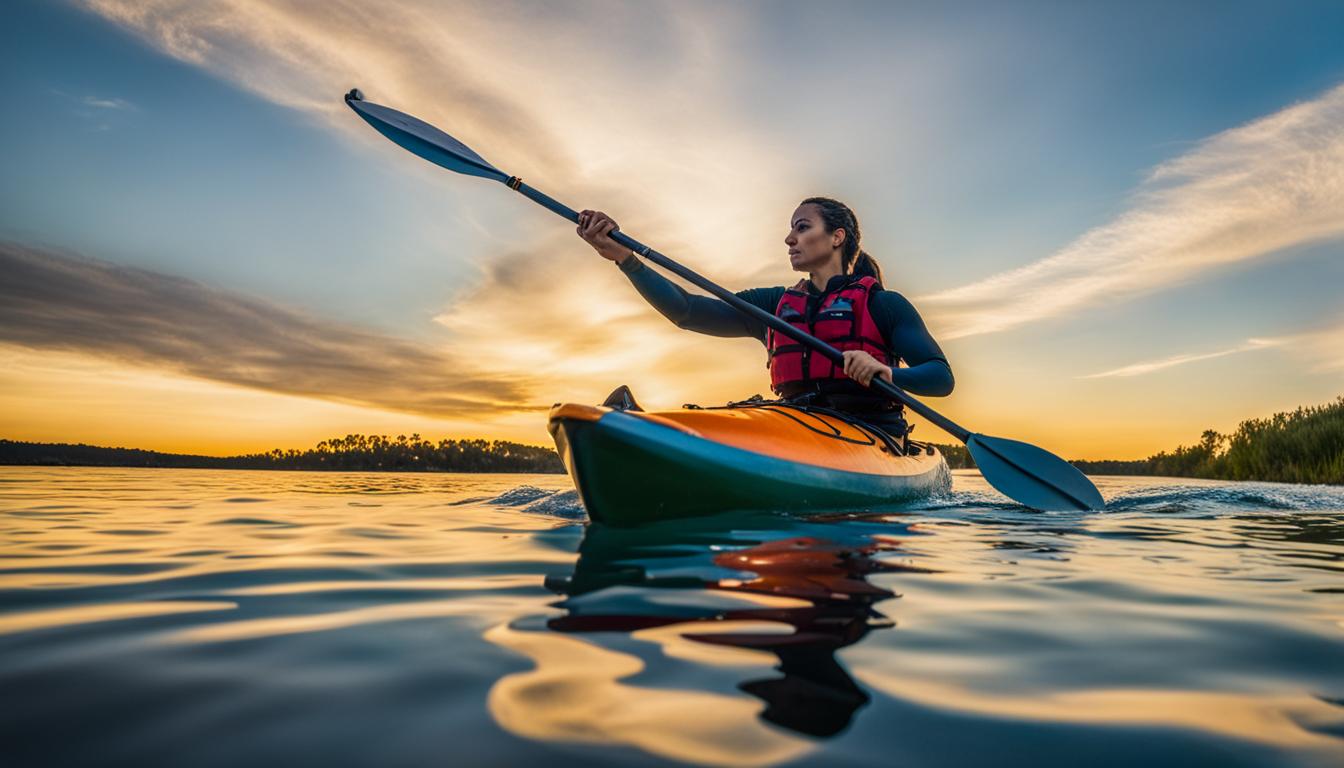If you’re looking to become a stronger paddler and improve your kayak stroke power, it’s important to build rotational strength. Rotational strength is key for efficient paddling and generating power through the kayak stroke. By targeting specific muscle groups, such as the back, shoulders, chest, arms, abdominals, and hips/legs, you can enhance your rotational strength and improve your paddling performance. This article will provide techniques and exercises to help you build rotational strength for paddling.
Key Takeaways:
- Rotational strength is essential for improving kayak stroke power and paddling performance.
- Target specific muscle groups like the back, shoulders, chest, arms, abdominals, and hips/legs for enhanced rotational strength.
- Exercises such as bent over rows, chest presses, lat pulldowns, deadlifts, pushups, and Russian twists can help build rotational strength.
- Using kayak-specific equipment like dumbbells, resistance bands, and TRX suspension trainers can further enhance rotational strength.
- Gradually increase the intensity and volume of your training to avoid injury and promote progress.
The Importance of Rotational Strength in Kayaking
When it comes to kayaking, having strong rotational strength is crucial for paddlers. By improving your rotational core for paddling and enhancing your rotational strength through dedicated training, you can significantly enhance your stroke efficiency, endurance, and overall performance on the water. Rotational strength plays a vital role in maintaining stability, maximizing the power generated through each stroke, and preventing injury.
One of the key benefits of having good rotational strength is the ability to generate power through the torso’s natural rotation. As you paddle, your torso naturally rotates to generate the force needed to propel the kayak forward. This rotation is powered by the core muscles, including the abdominals, obliques, and lower back. By strengthening these muscles, as well as the shoulders and hips, you can increase the efficiency of your paddle stroke and achieve a smoother and more powerful kayaking experience.
To enhance your rotational strength, core rotation training is essential for kayakers. This type of training focuses on exercises that specifically target the muscles involved in rotational movements. By incorporating exercises such as Russian twists, woodchoppers, and seated medicine ball rotations into your routine, you can engage and strengthen the core muscles responsible for generating rotational power. It’s important to perform these exercises with proper form and gradually increase the intensity as your strength improves.
“Improving rotational core for paddling, enhancing rotational strength in kayaking, core rotation training for kayakers.”
In addition to core rotation training, it’s crucial to maintain overall strength and flexibility throughout your body. By incorporating exercises that target the upper body, lower body, and cardiovascular system, you can achieve a well-rounded fitness routine that supports your kayaking performance. Examples of such exercises include push-ups, lunges, squats, and cardio activities like running or cycling. Remember to always listen to your body, start with proper form, and progress at a pace that is suitable for your fitness level.
The table below illustrates the primary muscle groups involved in kayaking and provides examples of exercises that can help you build rotational strength in each area:
| Muscle Group | Exercises |
|---|---|
| Core (Abdominals, Obliques, Lower Back) | Russian Twists, Woodchoppers, Seated Medicine Ball Rotations |
| Shoulders | Shoulder Press, Lateral Raises, Upright Rows |
| Hips | Squats, Lunges, Hip Abduction/Adduction Exercises |
| Upper Back | Bent Over Rows, Lat Pulldowns, Reverse Flyes |
| Arms | Push-Ups, Bicep Curls, Tricep Dips |

By incorporating these exercises into your training routine, you can develop the necessary strength and coordination to improve your paddle stroke power and efficiency. Remember to always prioritize proper form, gradually increase intensity, and give your body the rest it needs to recover and grow stronger. With consistent effort and dedication to improving your rotational strength, you’ll be able to take your kayaking skills to the next level and enjoy the benefits of enhanced performance on the water.
Exercises for Building Rotational Strength
If you’re a kayaker looking to improve your paddling efficiency, incorporating rotational strength exercises into your training routine is essential. These dynamic rotational exercises target the specific muscle groups involved in the paddle stroke, helping you develop the strength and coordination needed to enhance your kayak stroke power.
One effective exercise for building rotational strength is the Russian twist. Sit on the ground with your knees bent and feet flat. Hold a medicine ball or dumbbell with both hands and rotate your torso from side to side, touching the weight to the ground on each side. This exercise engages your oblique muscles and enhances your rotational power.
Another exercise that targets the back, shoulders, and arms is the bent over row. Stand with your feet hip-width apart and hinge forward from the hips while keeping your back straight. Hold a dumbbell in each hand, palms facing towards your body. Lift the weights towards your chest, squeezing your shoulder blades together. Lower the weights with control and repeat for several reps. This exercise strengthens the muscles involved in the pulling motion of the paddle stroke.
Table: Rotational Strength Exercises
| Exercise | Target Muscles |
|---|---|
| Russian Twist | Obliques |
| Bent Over Row | Back, Shoulders, Arms |
| Chest Press | Chest, Arms |
| Lat Pulldown | Back, Shoulders, Arms |
| Deadlift | Legs, Back |
| Pushups | Chest, Shoulders, Arms |
Remember to perform these exercises with proper form and gradually increase the weights and intensity as you get stronger. Combine these rotational strength workouts with your regular paddling practice to see significant improvements in your paddling efficiency and overall performance on the water. Keep challenging yourself and enjoy the benefits of enhanced rotational strength!
Kayak-Specific Rotational Strength Techniques and Core Rotation Training for Kayakers
When it comes to building rotational strength for paddling, it’s important to incorporate kayak-specific techniques and core rotation training into your routine. These specialized exercises target the muscles and movements that are essential for effective paddling and can help you enhance your performance on the water.
Kayak-Specific Rotational Strength Techniques
One effective way to build rotational strength is by simulating the paddle stroke motion during your training. This can be done using resistance bands or a TRX suspension trainer. Attach the band or TRX to a sturdy anchor point and stand facing it. Grab the handles or bands with your hands at about shoulder-width apart and extend your arms forward. From this starting position, initiate a twisting motion by rotating your torso to one side, then back to the center, and finally to the other side. This exercise mimics the rotation you would use while paddling and helps strengthen the core and stabilizer muscles.
Core Rotation Training for Kayakers
In addition to kayak-specific techniques, core rotation training is crucial for developing the rotational strength necessary for paddling. One effective exercise for core rotation is the Russian twist. Sit on the ground with your knees bent and feet flat on the floor. Hold a dumbbell or medicine ball with both hands, and lean back slightly to engage your core. From here, rotate your torso to one side, bringing the weight towards the ground next to your hip. Return to the center and then rotate to the other side. This exercise targets the obliques and helps improve rotational power and stability.
| Exercise | Description |
|---|---|
| Simulated Paddle Stroke | Using resistance bands or a TRX suspension trainer, mimic the paddle stroke motion by rotating your torso from side to side. |
| Russian Twist | Sit on the ground and hold a dumbbell or medicine ball with both hands. Rotate your torso from side to side, bringing the weight towards the ground next to your hip. |
Incorporating these kayak-specific rotational strength techniques and core rotation training into your regular workout routine can help you build the necessary strength and stability for efficient paddling. Remember to start with proper form, gradually increase the intensity, and listen to your body to avoid overexertion or injury. With consistent training and dedication, you’ll be well on your way to improving your rotational strength and enhancing your kayak stroke power.

Conclusion
Enhancing rotational strength in kayaking is crucial for improving your kayak stroke power and overall performance on the water. By incorporating exercises that target the specific muscle groups involved in the paddle stroke and using appropriate equipment, you can effectively build rotational strength and increase your paddling efficiency.
Remember to start with proper form and gradually increase the intensity of your training to avoid injury. Listening to your body and giving it the rest it needs is essential for long-term progress. So, make sure to include rotational strength training in your regular routine and enjoy the benefits of enhanced rotational strength on the water!
By focusing on building rotational strength, you’ll experience greater power and control in your kayak stroke. Whether you’re a recreational paddler or a competitive athlete, improving your rotational strength will help you paddle with more efficiency and effectiveness, giving you a competitive edge. So, don’t underestimate the importance of rotational strength in kayaking and start incorporating these exercises and techniques into your training regimen today!
FAQ
What is rotational strength and why is it important for paddling?
Rotational strength refers to the ability to generate power through rotational movements of the torso. In paddling, rotational strength is crucial for efficient stroke power and overall performance on the water.
Which muscle groups should I target to improve my rotational strength for paddling?
To enhance your rotational strength for paddling, it’s important to focus on muscle groups such as the back, shoulders, chest, arms, abdominals, and hips/legs.
What exercises can I do to build rotational strength for paddling?
Some exercises that can help you build rotational strength for paddling include bent over rows, chest presses, lat pulldowns, deadlifts, pushups, and Russian twists.
What equipment should I use to effectively build rotational strength for paddling?
Recommended equipment for building rotational strength includes dumbbells, resistance bands, and TRX suspension trainers. These tools can help target the specific muscle groups involved in the kayak stroke.
Are there any kayak-specific rotational strength techniques I should incorporate into my training?
Yes, it’s beneficial to simulate the paddle stroke motion and engage the core and stabilizer muscles during your rotational strength training. This will further enhance your paddling performance.
How should I progress my rotational strength training to avoid injury and promote progress?
It’s important to start with suitable weights and gradually increase the intensity and volume of your training. Listening to your body and maintaining proper form will help prevent injury and promote progress in your rotational strength building.
How will building rotational strength improve my paddling performance?
By developing rotational strength, you can increase your paddling efficiency, endurance, and overall power on the water. Improving your rotational core for paddling leads to better stroke power and increased stability.
How often should I incorporate rotational strength training into my routine?
To see significant improvements in your paddling skill and power, it’s recommended to incorporate rotational strength training into your regular routine. Consistency is key for progress.
Can building rotational strength help prevent injury while kayaking?
Yes, having a strong core and rotational muscles can help maintain stability and prevent injury while kayaking. By improved rotational strength, you can reduce the risk of strains or imbalances during your paddle strokes.





